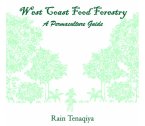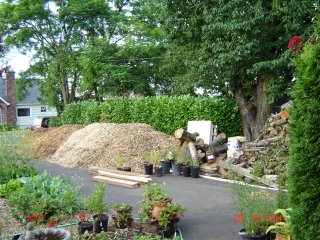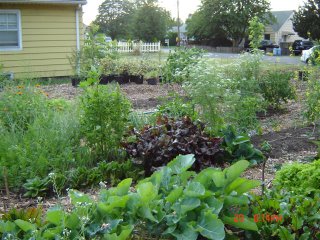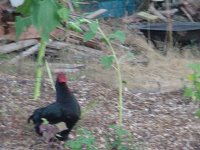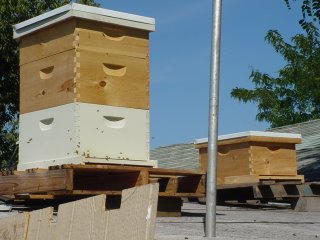I'm fresh off my stint of experimental fossil-fuel-free living, and here's a report-back on what it involved. I'm adding footnotes throughout for certain products or concepts with URLs for more info.
My basic premise was to eliminate active use of fossil fuels, meaning no electricity, petroleum, or natural gas use. As this was an excercise in preparation for rising energy costs and potential disruption of energy supplies, I did not attempt the impossible feat of living without using anything made of fossil fuels or manufactured & transported by fossil fuel energy. Two other exceptions I made up front were:
- Not limiting my food preservation activities (drying food in an electric dehydrator, since we don't have a solar dehydrator (1) constructed yet, and canning produce on a propane burner for which I have no good ideas for
substitution)
- Not avoiding meetings or places simply because they had lights on (Portland Peak Oil meetings, the library, etc)
TransportationThis was easy for me, since I rarely need to go anywhere and already bike when I do venture out. (See exception under "Cheats" section.)
Washing Dishes / Bathing / LaundryThe house in which I live has the fascinating feature of a garden hose fully exposed to sun on the exterior south wall of the house, providing an easy way to kill any plants you dislike. The setup has the added benefit of providing water too hot for immersion of your hand. This became my source of hot water for bathing, laundry, and for washing dishes/canning jars/storage buckets/etc.
I took sponge baths which used about 1.5 gallons of hot water per bath (and I could probably further reduce that usage). In the words of my housemate, I "don't stink too much!" which I guess means the baths were a success.
I did laundry with the Wonder Wash pressure washer
(2), a device I've had since last fall. You add hot water, detergent, and clothes, then screw the top down to create an airtight seal and manually rotate the laundry drum for about 2 minutes. The high pressure environment inside forces the water and detergent through the clothes. Water and detergent usage is minimal, and the clothes smell clean to me. It doesn't do well at removing stains; perhaps by applying special stain removal stuff I could take care of that too, but I've never cared about stains in my clothes so I haven't bothered to experiment with that.
Clothes of course were dried on a drying rack, outside.
LightingI carried my bike front headlight in my pocket wherever I went, to use during the daytime in dark basements/garages, and to use at night as needed. The light's batteries were charged using a solar battery charger
(3).
I tried unsuccessfully to get on a sleeping schedule of 10 PM - 7 AM, to make near maximum use of daylight hours while accomodating Portland Peak Oil meetings and other occasional night activities. I had a very hard time falling asleep each night, mostly due (I think) to environmental factors of an overheated bedroom with no shades on the west facing window and the window facing directly into a noisy neighborhood. Yesterday evening I finally wedged a towel across the window which did wonders for
blocking the evening sun and allowing me to close the window at bedtime to block out the noise. This should make it a lot easier to fall into a sensible sleep schedule minimizing the need to turn on lights.
Other ElectricityThis barely warrants mention, but the wireless phone used by our household requires electricity, so with the blessing of Pete (Leah was out of town) I added an older non-electric phone.
I don't watch any TV and only the occasional movie, so it wasn't difficult to do without those. I do frequently listen to recorded music, and at times wished I could turn on the stereo while working on other things...but not so much that I ever got around to finding my portable CD player and solar charging a couple more batteries.
Going without computer use (mostly--see "Cheats" section below) was somewhat difficult, though also hugely relieving in some ways. I lose a *lot* of time to email and reading up on news which is really irrelevant since I already know that I need to spend my time learning as many useful skills as I can and getting as much sustainable infrastructure into place as I can. There were a few projects on which I was working where internet access would have been helpful, and I mostly just made sure I researched what I needed before I began the fossil fuel fast, or postponed the
projects rather than waste time muddling through them without the info I felt I needed. It helps that suddenly it looks like I'll be moving to a new place in a month or so, making the planting of seeds at my current location mostly pointless and eliminating the need for me to research details of every seed I had intended to plant.
Cooking / FoodThis was absolutely the hardest aspect of the experiment for me, dependent as I am (and presumably as most of us are) on refrigeration and the ability to cook food at will with an electric or gas stove. Most of my diet is based on dumpster-dived
(4) food which generally needs to be refrigerated to remain fresh for more than a couple of days, and I do not have a cool root cellar. I tried to manage temperatures by moving a few foods back and forth between the basement and the house as temperatures fluctuated through the day, but it was still too warm for optimum food storage.
I learned how to sprout seeds for raw consumption, doing a few batches of adzuki beans and one batch of wheat. These made good snacks on their own or additionns to salads, sandwiches, and meals of rice & beans.
I ate a lot of stale dumpster-dived bread (which works much better when rejuvinated with a little toasting) with Earth Balance (butter substitute which holds up reasonably well without refrigeration) and jars of preserves, fruit butters, and jams which I could eat through within 2-3 days. Some sandwiches consisted of Earth Balance, arugula, tomatoes, and whatever sprouts or solar cooked beans were on hand.
I built a parabolic solar reflector oven
(5) for cooking. It worked great with the very first experiment, cooking nearly two cups of dried beans. I also had great success cooking rice and beans together. I experimented with other configurations to allow for easier cooking or larger batches and to find the optimum setup. This was a big help in allowing me to eat at least some cooked meals, and I think a much better option (when the sun is shining, at least) than cutting down trees to burn wood.
Since our community garden had no success in growing proper lettuce, I ate two weed salads comprised mostly of volunteer amaranths and dwarf mallow. Dumpster-dived tomatoes and/or sprouts and a good dosage of salad dressing helped make the salads palatable, but obviously not so desirable as to wean me away from dependence on stale bread and into healthier daily salads as I had originally envisioned. :/
Difficulties / CheatsThree times I went online to deal with email/internet tasks requiring immediate attention, and each time was easily distracted by other emails, checking news, etc. It's a big challenge for me when online to focus on specific tasks and not waste time on other non-critical clicks. There's too much valuable info online for me to seriouly consider cutting myself off completely, but I need to find ways to keep myself focused and efficient so I can do the necessary research but then get back to the most important piece: action on the ground.
I did use a car once, to pick up a special order of beans from the food coop half a mile away. That could have been avoided with multiple trips on Theressa's bike, which is outfitted with a basket, or with a bike trailer, which I have not yet researched. For now I decided to just do the time-efficient thing and drive, knowing that a bike upgrade & bike trailer is high on the list of to-do projects.
I went out to eat several times and participated in two potlucks, all undermining the food portion of the experiment. (For one of the potlucks I brought a dish with beans cooked in the solar funnel, but corn steamed via propane and some ingredients which had been refrigerated.) I ate out so often not because I was actively avoiding figuring out something at home, but rather because of several invitations to go out. No matter the intention, it had a very real impact on my food situation and my diet
would have been even harder without those "cheats."
And of course there's the general issue of dependence on infrastructure based on cheap fossil fuels...the aluminum foil I bought at the store to make the solar funnel, the duct tape and super glue I bought to patch up my clothes drying rack, the black spray paint for the glass jars and pots used with the solar funnel, and the many items I already own but which have finite lifespans and may or may not be easily replaceable in the future. Lots to think about and plan for there...
SummaryThis was an excellent experiment for me, and a great incentive to finally implement some of the projects I've had on my list, especially the solar funnel, learning to sprout seeds for consumption, learning to sponge bathe, and experimenting more with the laundry pressure washer (shelved since last fall, when I discovered it wasn't much fun to hand-wring water from clothes in 50 degree weather).
I did not do as well as I'd hoped in finding ways to eat enjoyable raw foods, as so far I'm not crazy about sprouts, and the salads I made weren't great. The solar cooking thing is wonderful, but has limited applicability most of the year in our cloudy Pacific Northwest climate. In general, food production, storage, and preparation, which are the most important pieces of sustainability, promise to be the hardest aspects for me to disentangle from dependency on modern appliances and fossil fuels. The rest of my life has already been largely pared down to the basics, but
it turns out that, no matter what, I still need to eat!
I intend to integrate many of the practices of the last 10 days into my regular life now, and to focus on the challenges (especially around food) and keep working on ways to reduce energy usage and dependency without feeling like I'm sacrificing my standard of living (or losing weight!) Perhaps by this time next year I'll be living fossil-fuel-free routinely in the summer, and ready to embark on the even larger challenge of going without fossil fuels through the winter!
Footnotes(1) Solar Dehydrator: I'll start with the easiest design I've found, at
http://www.i4at.org/surv/soldehyd.htm(2)
Wonder Wash pressure washer: about $50 with shipping
(3) $15
Solar battery chargerI also recommend some way to check the charge on your rechargeable
batteries...I purchased the $15
Digital Battery Checker from the same
website to get free shipping on the two items, but I'm not too impressed
with it, as it requires a AAA battery to function and seems to have a hard
time sometimes making terminal contacts to display the charge.
(4) For more on the subject, read
The Art & Science of Dumpster Divingby John Hoffman
(5) Parabolic solar reflector: Easiest design I could find is at
http://solarcooking.org/funnel.htm

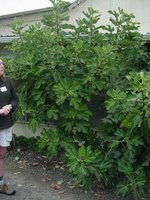 Figs crop twice, once in the summer and again in the fall. Some varieties have their main, heaviest crop in the summer, and others in the fall. In this region, Desert King is a good variety for a heavy 1st crop. Latarulla is a good variety for a heavy 2nd crop. Figs are somewhat deer resistant, due to their latex. The fig on the left is Latarulla, on the right is Peter's Honey, 3-4 years after planting as a 1-2 year old cutting propagation. Of the figs OGW sells, Peter's Honey is the sweetest, but has the longest ripening time so needs a good warm spot outside of Portland in this region. (In Portland we're a warmer microclimate in general already.)
Figs crop twice, once in the summer and again in the fall. Some varieties have their main, heaviest crop in the summer, and others in the fall. In this region, Desert King is a good variety for a heavy 1st crop. Latarulla is a good variety for a heavy 2nd crop. Figs are somewhat deer resistant, due to their latex. The fig on the left is Latarulla, on the right is Peter's Honey, 3-4 years after planting as a 1-2 year old cutting propagation. Of the figs OGW sells, Peter's Honey is the sweetest, but has the longest ripening time so needs a good warm spot outside of Portland in this region. (In Portland we're a warmer microclimate in general already.)


 Flowering quince has citrus-like fruit on shrubs. I keep wondering whether the fruit has the same acidic properties and whether it can be used straight-up in recipes.
Flowering quince has citrus-like fruit on shrubs. I keep wondering whether the fruit has the same acidic properties and whether it can be used straight-up in recipes.

 Persimmons - astringent types can be fast-ripened overnight in hot water at the right temperature. Astringent varieties are always sweeter than non-astringent. The persimmon on the left is an American persimmon, which are all large trees with relatively small, astringent fruit. On the right are two different Asian persimmons, one so loaded with fruit its branches are badly in need of extra support! The Saijo persimmon is ideal for drying (and from other conversations I've had with OGW, seems to be the only proven astringent variety for this area.) Fuyu is a dry crisp [did I get that right?] non-astringent variety.
Persimmons - astringent types can be fast-ripened overnight in hot water at the right temperature. Astringent varieties are always sweeter than non-astringent. The persimmon on the left is an American persimmon, which are all large trees with relatively small, astringent fruit. On the right are two different Asian persimmons, one so loaded with fruit its branches are badly in need of extra support! The Saijo persimmon is ideal for drying (and from other conversations I've had with OGW, seems to be the only proven astringent variety for this area.) Fuyu is a dry crisp [did I get that right?] non-astringent variety.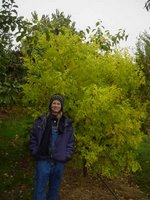 Jujubes are late to leaf out, as late as June. The variety "Coco", when dead ripe, has a coconut flavor. (I tried this variety inside at their sample table and thought it tasted, like all jujubes I've tried, like a cardboard apple--and not even a coconuty cardboard apple. :/ ) They are attractive shrubs, as seen in the picture on the left.
Jujubes are late to leaf out, as late as June. The variety "Coco", when dead ripe, has a coconut flavor. (I tried this variety inside at their sample table and thought it tasted, like all jujubes I've tried, like a cardboard apple--and not even a coconuty cardboard apple. :/ ) They are attractive shrubs, as seen in the picture on the left. Autumn Olives are large shrubs of the Elaeagnus genus, meaning they fix nitrogen and produce tasty red berries. We munched on a lot of them from different plants. All were good, but the "Ruby" variety was slightly sweeter and tastier. "Garnet" appears to be a seedling selected by OGW to ensure pollination for "Ruby" when they sell it, since they're unsure of whether Autumn Olives are self fertile.
Autumn Olives are large shrubs of the Elaeagnus genus, meaning they fix nitrogen and produce tasty red berries. We munched on a lot of them from different plants. All were good, but the "Ruby" variety was slightly sweeter and tastier. "Garnet" appears to be a seedling selected by OGW to ensure pollination for "Ruby" when they sell it, since they're unsure of whether Autumn Olives are self fertile. Seaberries are highly prized in Russia, and used for commercial juice in Europe (especially or only Germany?). They must be sweetened to become palatable, though last year there was someone on the tour who said he ate them raw from his bush. For easy harvesting in Germany(?), they cut off entire branches and freeze them, which then makes it easy to mechanically knock off the berries. With this setup plants have to be on a two year rotation, since the cut branches can't crop the following year.
Seaberries are highly prized in Russia, and used for commercial juice in Europe (especially or only Germany?). They must be sweetened to become palatable, though last year there was someone on the tour who said he ate them raw from his bush. For easy harvesting in Germany(?), they cut off entire branches and freeze them, which then makes it easy to mechanically knock off the berries. With this setup plants have to be on a two year rotation, since the cut branches can't crop the following year. The Medlar in the background is about 12' tall. Medlars are tip-bearers. The "Nottingham" variety is annoying because the fruit tends to fall off before its ripe. Some varieties, especially those with larger fruit, are prone to the fruit splitting, but apparently this doesn't cause any problems besides aesthetic. There was a vague report of dipping medlars in salt water and hanging upside down to do something...preserve them? Medlars have to "blet", aka "rot", to soften up before eating. This can happen on the tree, or you can pick them and blet them indoors.
The Medlar in the background is about 12' tall. Medlars are tip-bearers. The "Nottingham" variety is annoying because the fruit tends to fall off before its ripe. Some varieties, especially those with larger fruit, are prone to the fruit splitting, but apparently this doesn't cause any problems besides aesthetic. There was a vague report of dipping medlars in salt water and hanging upside down to do something...preserve them? Medlars have to "blet", aka "rot", to soften up before eating. This can happen on the tree, or you can pick them and blet them indoors.
 Pineapple guavas are slow growers, but grow faster with supplementary water in the summer. This hedge of 4 was planted in the 01990s, froze and died to the ground, and then grew back. One guy mentioned that wind in the winter knocked off lots of his leaves. In a hard freeze, new leaves fall off. I guess that would make pineapple guavas semi-evergreen, and not suitable for winter windbreaks.
Pineapple guavas are slow growers, but grow faster with supplementary water in the summer. This hedge of 4 was planted in the 01990s, froze and died to the ground, and then grew back. One guy mentioned that wind in the winter knocked off lots of his leaves. In a hard freeze, new leaves fall off. I guess that would make pineapple guavas semi-evergreen, and not suitable for winter windbreaks.
